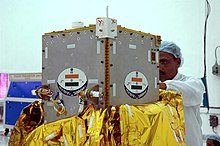
A lander is a spacecraft that descends towards, then comes to rest on the surface of an astronomical body other than Earth. In contrast to an impact probe, which makes a hard landing that damages or destroys the probe upon reaching the surface, a lander makes a soft landing after which the probe remains functional.
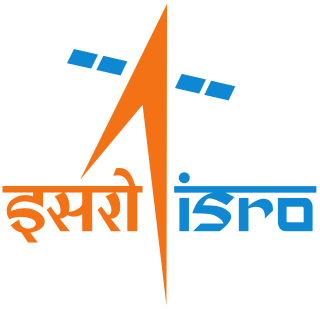
The Indian Space Research Organisation is India's national space agency. It serves as the principal research and development arm of the Department of Space (DoS), overseen by the Prime Minister of India, with the Chairman of ISRO also serving as the chief executive of the DoS. It is primarily responsible for space-based operations, space exploration, international space cooperation and the development of related technologies. The agency maintains a constellation of imaging, communication and remote sensing satellites. It operates the GAGAN and IRNSS satellite navigation systems. It has sent three missions to the Moon and one mission to Mars.

Shackleton is an impact crater that lies at the lunar south pole. The peaks along the crater's rim are exposed to almost continual sunlight, while the interior is perpetually in shadow. The low-temperature interior of this crater functions as a cold trap that may capture and freeze volatiles shed during comet impacts on the Moon. Measurements by the Lunar Prospector spacecraft showed higher than normal amounts of hydrogen within the crater, which may indicate the presence of water ice. The crater is named after Antarctic explorer Ernest Shackleton.

Chandrayaan-1 was the first Indian lunar probe under the Chandrayaan programme. It was launched by the Indian Space Research Organisation (ISRO) in October 2008, and operated until August 2009. The mission consisted of an orbiter and an impactor. India launched the spacecraft using a PSLV-XL rocket on 22 October 2008 at 00:52 UTC from Satish Dhawan Space Centre, at Sriharikota, Andhra Pradesh. The mission was a major boost to India's space program, as India researched and developed its own technology to explore the Moon. The vehicle was inserted into lunar orbit on 8 November 2008.

A Moon landing or lunar landing is the arrival of a spacecraft on the surface of the Moon, including both crewed and robotic missions. The first human-made object to touch the Moon was Luna 2 in 1959.
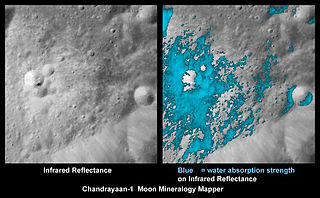
Lunar water is water that is present on the Moon. The search for the presence of lunar water has attracted considerable attention and motivated several recent lunar missions, largely because of water's usefulness in making long-term lunar habitation feasible.

The Moon Mineralogy Mapper (M3) is one of two instruments of NASA that was carried by India's first mission to the Moon, Chandrayaan-1, launched October 22, 2008. It is an imaging spectrometer, and the team is led by Principal investigator Carle Pieters of Brown University, and managed by NASA's Jet Propulsion Laboratory.

The Lunar Reconnaissance Orbiter (LRO) is a NASA robotic spacecraft currently orbiting the Moon in an eccentric polar mapping orbit. Data collected by LRO have been described as essential for planning NASA's future human and robotic missions to the Moon. Its detailed mapping program is identifying safe landing sites, locating potential resources on the Moon, characterizing the radiation environment, and demonstrating new technologies.
Jawahar is a male given name. The most prominent bearer of the name is Jawaharlal Nehru.

Chandrayaan-2 is the second lunar exploration mission developed by the Indian Space Research Organisation (ISRO) after Chandrayaan-1. It consists of a lunar orbiter, the Vikram lunar lander, and the Pragyan rover, all of which were developed in India. The main scientific objective is to map and study the variations in lunar surface composition, as well as the location and abundance of lunar water.

The Moon Impact Probe (MIP) developed by the Indian Space Research Organisation (ISRO), India's national space agency, was a lunar probe that was released by ISRO's Chandrayaan-1 lunar remote sensing orbiter which in turn was launched, on 22 October 2008, aboard a modified version of ISRO's Polar Satellite Launch Vehicle. It discovered the presence of water on the Moon.
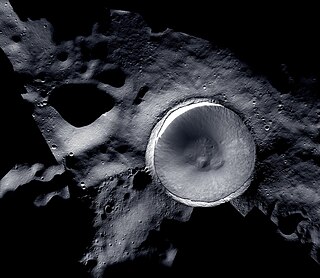
The lunar south pole is the southernmost point on the Moon. It is of interest to scientists because of the occurrence of water ice in permanently shadowed areas around it. The lunar south pole region features craters that are unique in that the near-constant sunlight does not reach their interior. Such craters are cold traps that contain fossil records of hydrogen, water ice, and other volatiles dating from the early Solar System. In contrast, the lunar north pole region exhibits a much lower quantity of similarly sheltered craters.
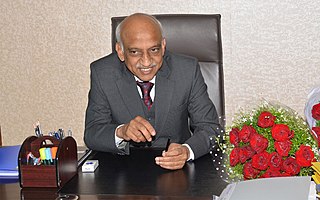
Aluru Seelin Kiran Kumar is an Indian space scientist and former chairman of the Indian Space Research Organisation, having assumed office on 14 January 2015. He is credited with the development of key scientific instruments aboard the Chandrayaan-1 and Mangalyaan space crafts. In 2014, he was awarded the Padma Shri, India's fourth highest civilian award, for his contributions to the fields of science and technology. Kiran Kumar previously served as Director of Ahmedabad Space Applications Centre.
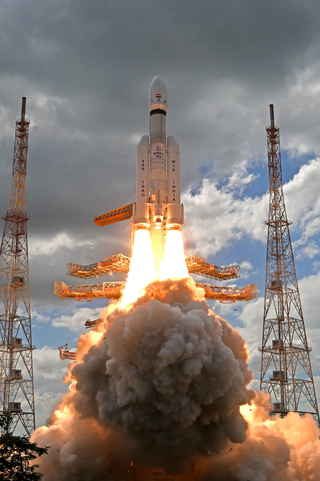
The Chandrayaan programme also known as the Indian Lunar Exploration Programme is an ongoing series of outer space missions by the Indian Space Research Organization (ISRO) for the exploration of the Moon. The program incorporates a lunar orbiter, an impactor, a soft lander and a rover spacecraft.
The following outline is provided as an overview of and topical guide to the Moon:

Pragyan is a lunar rover that forms part of Chandrayaan-3, a lunar mission developed by the Indian Space Research Organisation (ISRO).
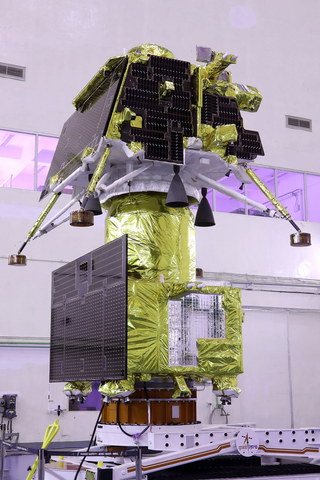
Chandrayaan-3 is the third mission in the Chandrayaan programme, a series of lunar-exploration missions developed by the Indian Space Research Organisation (ISRO). The mission consists of a Vikram lunar lander and a Pragyan lunar rover was launched from Satish Dhawan Space Centre on 14 July 2023. The spacecraft entered lunar orbit on 5 August, and India became the first country to touch down near the lunar south pole, at 69°S, the southernmost lunar landing on 23 August 2023 at 18:04 IST, ISRO became the first agency to land near the south pole of the moon in its first attempt and overall the fourth space agency to successfully land on the Moon, after USSR, NASA and the CNSA.

Statio Shiv Shakti or Shiv Shakti Point is the landing site of Chandrayaan-3, the third lunar mission of Indian Space Research Organisation (ISRO). The mission's lander Vikram and rover Pragyan landed 600 km from the south pole of the Moon on 23 August 2023. The landing site was named on 26 August 2023 at the ISTRAC headquarters in Bengaluru, after India became the fourth nation to make a successful soft landing on the Moon and also becoming the first country that landed on the lunar south pole. Statio Shiv Shakti is located at the coordinates 69.373°S 32.319°E and lies between the lunar craters Manzinus C and Simpelius N. It has been proposed that the upcoming sample-return mission Chandrayaan-4 also land near the point.
The Tiranga Point is a location on the Moon near the lunar south pole where Chandrayaan-2's lander Vikram crashed. The site was named on 26 August 2023 at the ISTRAC headquarters in Bengaluru. It is located on the coordinates 70.8810°S 22.7840°E and it lies between Manzinus C and Simpelius N craters.

Pragyan is a lunar rover that forms part of Chandrayaan-2, a lunar mission developed by the Indian Space Research Organisation (ISRO). The rover was launched as part of Chandrayaan-2 on 22 July 2019 and was destroyed with its lander, Vikram, when it crashed on the Moon on 6 September 2019.

